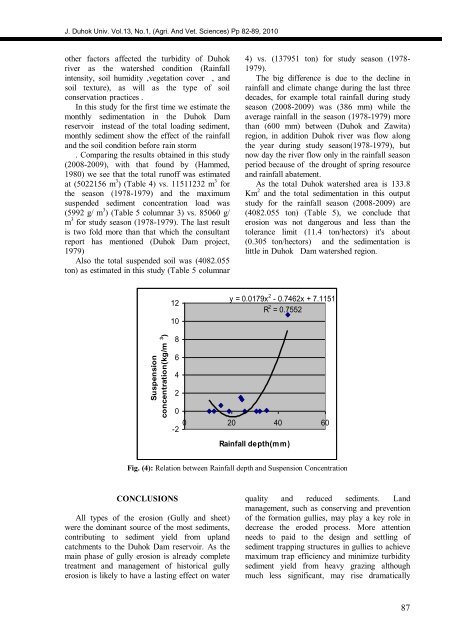The Influence Of Priming Two Cucumber Cultivar Seeds
The Influence Of Priming Two Cucumber Cultivar Seeds
The Influence Of Priming Two Cucumber Cultivar Seeds
Create successful ePaper yourself
Turn your PDF publications into a flip-book with our unique Google optimized e-Paper software.
J. Duhok Univ. Vol.13, No.1, (Agri. And Vet. Sciences) Pp 82-89, 2010<br />
other factors affected the turbidity of Duhok<br />
river as the watershed condition (Rainfall<br />
intensity, soil humidity ,vegetation cover , and<br />
soil texture), as will as the type of soil<br />
conservation practices .<br />
In this study for the first time we estimate the<br />
monthly sedimentation in the Duhok Dam<br />
reservoir instead of the total loading sediment,<br />
monthly sediment show the effect of the rainfall<br />
and the soil condition before rain storm<br />
. Comparing the results obtained in this study<br />
(2008-2009), with that found by (Hammed,<br />
1980) we see that the total runoff was estimated<br />
at (5022156 m 3 ) (Table 4) vs. 11511232 m 3 for<br />
the season (1978-1979) and the maximum<br />
suspended sediment concentration load was<br />
(5992 g/ m 3 ) (Table 5 columnar 3) vs. 85060 g/<br />
m 3 for study season (1978-1979). <strong>The</strong> last result<br />
is two fold more than that which the consultant<br />
report has mentioned (Duhok Dam project,<br />
1979)<br />
Also the total suspended soil was (4082.055<br />
ton) as estimated in this study (Table 5 columnar<br />
Suspension<br />
concentration(kg/m 3 )<br />
12<br />
10<br />
8<br />
6<br />
4<br />
2<br />
0<br />
4) vs. (137951 ton) for study season (1978-<br />
1979).<br />
<strong>The</strong> big difference is due to the decline in<br />
rainfall and climate change during the last three<br />
decades, for example total rainfall during study<br />
season (2008-2009) was (386 mm) while the<br />
average rainfall in the season (1978-1979) more<br />
than (600 mm) between (Duhok and Zawita)<br />
region, in addition Duhok river was flow along<br />
the year during study season(1978-1979), but<br />
now day the river flow only in the rainfall season<br />
period because of the drought of spring resource<br />
and rainfall abatement.<br />
As the total Duhok watershed area is 133.8<br />
Km 2 and the total sedimentation in this output<br />
study for the rainfall season (2008-2009) are<br />
(4082.055 ton) (Table 5), we conclude that<br />
erosion was not dangerous and less than the<br />
tolerance limit (11.4 ton/hectors) it's about<br />
(0.305 ton/hectors) and the sedimentation is<br />
little in Duhok Dam watershed region.<br />
y = 0.0179x 2 - 0.7462x + 7.1151<br />
R 2 = 0.7552<br />
0 20 40 60<br />
-2<br />
Rainfall depth(mm)<br />
Fig. (4): Relation between Rainfall depth and Suspension Concentration<br />
CONCLUSIONS<br />
All types of the erosion (Gully and sheet)<br />
were the dominant source of the most sediments,<br />
contributing to sediment yield from upland<br />
catchments to the Duhok Dam reservoir. As the<br />
main phase of gully erosion is already complete<br />
treatment and management of historical gully<br />
erosion is likely to have a lasting effect on water<br />
quality and reduced sediments. Land<br />
management, such as conserving and prevention<br />
of the formation gullies, may play a key role in<br />
decrease the eroded process. More attention<br />
needs to paid to the design and settling of<br />
sediment trapping structures in gullies to achieve<br />
maximum trap efficiency and minimize turbidity<br />
sediment yield from heavy grazing although<br />
much less significant, may rise dramatically<br />
28



